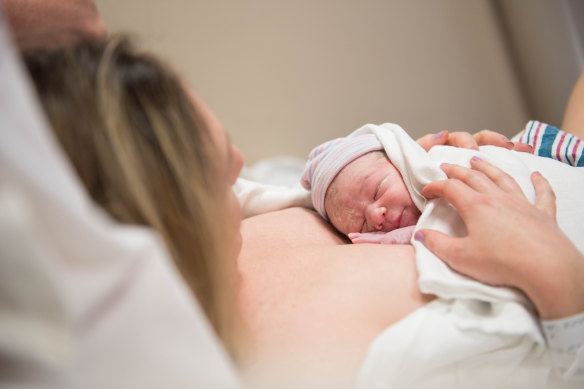Editorial
Response to birth trauma inquiry must recognise changing face of motherhood
The NSW parliamentary inquiry on birth trauma earlier this year heard the stories of thousands of women, detailing their experiences of psychological distress and physical injury while giving birth.
The state government will need to respond to its recommendations, which focus on prioritising midwife-led care, by the end of the month.

The NSW parliamentary inquiry on birth trauma risks becoming a case of midwives versus doctors. It must, instead, centre on modern mothers.Credit: Getty Images
As Mary Ward reports in today’s Sun-Herald, women are having caesarean births at a record rate in public and private hospitals statewide.
NSW Health’s annual Mothers and Babies report, published last month, showed only 50.2 per cent of women had a birth without intervention in 2022. Among private maternity patients, 49.4 per cent had a caesarean and almost 40 per cent had one that was planned.
Public caesarean births have also increased, from 29.8 per cent to 33.6 per cent of patients. The trend is being driven by elective, and not emergency, procedures.
Although the increase has been greatest in private hospitals, the widespread increase suggests this is not a case of being “too posh to push”. Women are giving birth later in life – the average age of a birthing mother in NSW is approaching 32 – and with a host of other health considerations that come with this, including higher BMI and the use of assistive reproductive technology.
According to private obstetricians, women are also more likely to elect to have a caesarean: they are having fewer children, so are less likely to be deterred by the risks associated with multiple procedures. But midwives say it is in the private sector’s business interest to encourage these women to have elective caesareans, expressing concern that natural birth is being demonised as an impossible, dangerous feat.
The birth trauma inquiry’s recommendations have heavily favoured midwife-led models of care, describing continuous midwifery care as the “gold standard”. The obstetricians and gynaecologists’ college foresaw this from the start, raising concerns about the loaded term “obstetric violence” used in the inquiry’s terms of reference in its submission.
The inquiry ran the risk of – and often strayed into – turning into a war between midwives and doctors. Looking at its recommendations, it is clear the midwives won: the report recommended the NSW government invest in and expand midwifery continuity of care models, address midwifery shortages and appoint a standalone chief midwifery officer (an unlikely prospect, given Labor MPs’ opposition).
But with so many women now giving birth via caesarean, the government must remember that, as various factors – career aspirations, housing, social change – push the age at which women have children later and later, their health needs and preferences may have changed.
In its response to the 43 recommendations of the birth trauma inquiry, the Minns government must ensure what is best for a woman’s physical and mental health – and her baby’s outcomes – is at the centre.
Last month, the Sun-Herald reported that several private maternity services in Australia had shut, pushing more women into the overburdened public system. Statistically, many of these women will have medical reasons to require a caesarean.
Operators have called for more insurance companies to include maternity services in lower policy tiers, instead of reserving the benefits for those on gold tier policies.
Every health practitioner involved in the birth journey agrees that women should be able to express preferences and receive the best care for herself and her baby. The Minns government needs to act to centre its response on modern motherhood.
The Morning Edition newsletter is our guide to the day’s most important and interesting stories, analysis and insights. Sign up here.